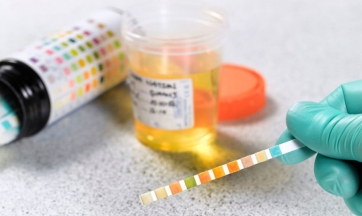NAG, or N-acetyl-β-D-glucosidase, is an endolysosomal enzyme predominantly found in the renal proximal tubule cells. It plays a crucial role in various pathological conditions, and alterations in urine and serum NAG activity are indicative of specific pathological states within the body. The substrate used for NAG detection undergoes hydrolysis catalyzed by NAG, resulting in the generation of products with a pronounced absorption peak at 340nm. The calculation of NAG activity involves measuring the rate of absorbance increase at 340nm per minute. This method provides valuable insights into the enzyme's activity and its correlation with certain health conditions.
NAG Summary
N-acetyl-beta-D-glucosidase (NAG)
Appearance: yellow liquid
Source: Microorganisms
Molecular weight: 57.8KD
Enzymology Commission Number: EC 3.2.1.52
Storage temperature: 2-8℃
Enzyme activity: 62.5U/L; 250U/L
Application: Calibrators and quality controls in NAG detection kits.
Detection principle:N-acetyl-β-D-glucosidase (NAG) catalyzes the hydrolysis of the substrate (taking MPT-NAG as an example) to generate the product 6-methyl -2 Mercaptopyridine (MPT), MPT has strong absorption at 340nm. The activity of NAG is calculated by measuring the absorbance increase rate at 340nm per minute.
NAG detection Clinical significance
Diagnosing kidney disease: glomerulonephritis, acute renal failure, nephrotic syndrome
Monitoring for nephrotoxicity
Detection of rejection after kidney transplantation
Heavy metal kidney damage monitoring
NAG Detection Substrates and Principles
CNP-NAG
Substrate: 2-Chloro-4-nitrobenzene-N-acetyl-β-D-glucosamine glycoside (CNP-NAG)
Measurement Principle: NAG acts on the substrate, hydrolyzing and liberating CNP. Its production rate is directly proportional to the enzyme activity within a specified range. Detection is performed at 400-405nm. The change in absorbance per minute (ΔA/min) is utilized to calculate NAG activity.
Advantages: The color develops directly under reaction conditions without alkalinization, meeting the criteria for rate method determination.
PNP-NAG
Substrate: 4-nitrobenzene-N-acetyl-β-D-glucosamine (PNP-NAG)
Measurement Principle: NAG acts on the substrate, hydrolyzing and releasing free PNP (p-nitrophenol), with its production rate proportionate to enzyme activity within a specific range.
Advantages: Simple operation, rapid and sensitive results, and reliability.
MPT-NAG
Substrate: 6-Methyl-2-thiopyridine-N-acetyl-β-D-glucosamine (MPT-NAG)
Measurement Principle: NAG catalyzes substrate hydrolysis, generating the product 6-methyl-2-mercaptopyridine (MPT), which exhibits strong absorption at 340nm. The increase in absorbance rate per minute is employed to calculate NAG activity.
Advantages: Strong anti-interference, high sensitivity, accurate results, suitable for large-volume sample operation in fully automatic biochemical analyzers.
VRA-NAG
Substrate: 5-[4-(3-Methoxy-phenyl-rhodanine)]-3-ammonium acetate-N-acetylamino-β -D-Glucoside (VRA-NAG)
Measurement Principle: NAG catalyzes the hydrolysis of the glycoside chain in the substrate, generating the product VRA. VRA exhibits an absorption peak max at 505nm. Calculating NAG activity is achieved by measuring the absorbance change rate per minute at 505nm.
Advantages: High sensitivity, accurate results, good liquid stability, suitable for operation in fully automatic biochemical analyzers.
For more product details, please contact us: service@seebio.cn or Phone: +86 21 58183719 or Wechat: +86 158 0195 7578
NAG Detection Substrate Product List
|
Item number
|
product name
|
CAS
|
|
DCE0085A
|
5-[4-(3-Methoxy-benzyl-rhodanine)]-3-ammonium acetate-N-acetamido-β-D-glucoside (VRA-NAG)
|
125261-87-2
|
|
DCE0138A
|
6-Methyl-2-thiopyridine-N-acetyl-β-D-glucoside (MPT-NAG)
|
149263-94-5
|
|
ACE0068A
|
p-Nitrophenyl-N-acetyl-β-D-glucosamine (PNP-NAG)
|
3459-18-5
|
|
DCE0085A
|
2-Chloro-p-nitrophenyl-N-acetyl-β-D-glucosamine (CNP-NAG)
|
103614-82-0
|

